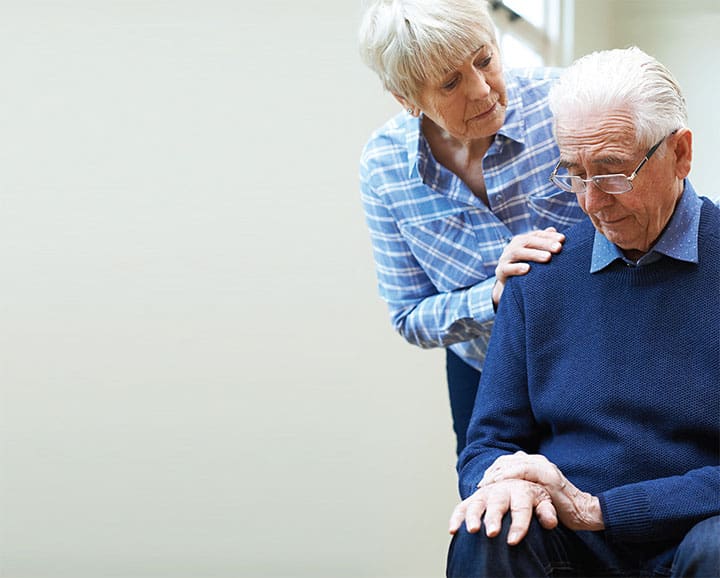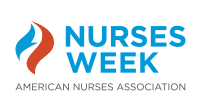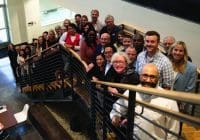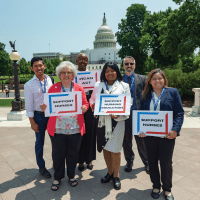School of nursing leaders take multi-pronged approach to support caregivers
By Susan Trossman, RN
Someone who must carry out a list of hospital discharge instructions or provide ongoing, complex care to a family member or friend can, at times, feel uncertain and overwhelmed by the caregiver role.
Nurse leaders at the Betty Irene Moore School of Nursing (SON) at the University of California, Davis, not only understand this, but also are engaged in a range of activities that offer a lifeline to family caregivers in need of support. Among their initiatives is the launching of the first-ever Family Caregiving Institute. It’s aimed, in part, at developing systems and tools to educate and bolster family caregivers who are managing nursing tasks and to prepare healthcare professionals to be more effective in supporting family care.
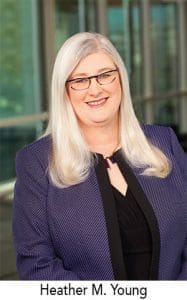
“[Support for caregivers] is an issue that continues to grow with the increasing number of older adults with chronic conditions who need functional support,” said Heather M. Young, PhD, RN, FAAN, founding dean of the UC Davis SON and an ANA\California member. “But the greatest need is helping individuals who are being asked to manage the complex care of their family members who are being discharged quicker and sicker.” For example, upon discharge, individuals may need multiple medications, including injections, complex dressing changes, and peritoneal dialysis, she noted.
Medication management in itself is complex, with tricky timing; some meds have to be given with food, some without food, and some after checking the heart rate, according to Terri Harvath, PhD, RN, FAAN, executive associate dean and lead researcher for the Institute. “We go to school to learn these things,” said Harvath, an ANA\C member. “But caregivers may just be given cursory instructions and often not asked to do a return demonstration. And because family caregiving has gone on for ages, we [healthcare professionals] have not done as good a job in recognizing how alone family caregivers are.”
 Young added, “When I started as a nurse, we’d ask the family to step out of the room if we were providing care, such as dressing changes. But these days caregivers need to learn how to do dressing changes and other [more advanced care]. So we need to change attitudes and practice.”
Young added, “When I started as a nurse, we’d ask the family to step out of the room if we were providing care, such as dressing changes. But these days caregivers need to learn how to do dressing changes and other [more advanced care]. So we need to change attitudes and practice.”
Even if the person discharged qualifies for home care visits, training provided to a caregiver is not a covered insurance benefit, according to Harvath. That said, she added, “Good home health nurses will work with families.”
But clearly more help for caregivers is needed.
The caregiver population
In their 2015 Report, Caregiving in the U.S., the AARP Public Policy Institute and the National Alliance for Caregiving noted that about 34.2 million Americans have provided unpaid care to an adult 50 years old and over in the previous 12 months.
Nearly one in 10 caregivers is 75 years old or older, and some 60% of all caregivers are women. Newer research has shown that besides assisting with activities of daily living, “family caregivers are increasingly performing tasks that nurses typically perform,” according to the report. Roughly six in 10 caregivers assist with medical or nursing tasks, such as tube feedings, catheter and colostomy care, and other complex tasks.
Further, 22% of surveyed caregivers reported that their health had suffered because of their role, with that number increasing to 27% if they had to perform medical or nursing tasks. Those taking care of someone with a mental health issue, Alzheimer’s or dementia, or a longstanding physical condition also described feeling particularly stressed emotionally.
Existing resources to build on
In fall 2016, AARP led an initiative to create a series of tutorial videos aimed at helping family caregivers manage complex nursing activities. Through partnership with Harvath and SON faculty researchers, the first series of five videos was produced, featuring scenarios around medication administration. One video focuses on a caregiver who calls a nurse hotline seeking help with administering oral medications to her mother-in-law who has dementia and is refusing to take them. Another features a primary family caregiver, who was trained by a nurse, giving her sister step-by-step instructions on how to place a pain medication patch on their mother, as well as give her eye drops and insert a rectal suppository.
The videos are realistic—showing the satisfaction the younger sister experiences when administering the eye drops successfully and the emotional discomfort she expresses in having to give her mother a suppository.
“We didn’t want to send a message that it’s easy [to provide certain nursing skills],” Harvath said. “There’s a learning curve and an emotional component. It’s hard for adult children or spouses to bathe or toilet a family member. It changes the nature of the relationship.”
 Since the initial production, AARP’s Home Alone Alliance, along with Harvath and expert clinicians from the Veterans Administration, have completed five more videos that give practical, crucial tips on various aspects of mobility, including how to help a family member transfer between a car and wheelchair, and what to do when someone falls. A series designed to help caregivers with wound and ostomy care is in final edits.
Since the initial production, AARP’s Home Alone Alliance, along with Harvath and expert clinicians from the Veterans Administration, have completed five more videos that give practical, crucial tips on various aspects of mobility, including how to help a family member transfer between a car and wheelchair, and what to do when someone falls. A series designed to help caregivers with wound and ostomy care is in final edits.
AARP and the SON are working on distributing the videos—most of which are also available in Spanish—more widely. For example, one effort is to include the videos on hospitals’ closed circuit platforms, where patients and family caregivers can view them in conjunction with discharge planning.
Four major areas of work
The Family Caregiving Institutes’s mission is to enhance the well-being and health of family caregivers and older adults with serious and chronic illnesses. Described by Harvath as “very much a work in progress,” the Institute’s creation is supported by a $5 million grant from the Gordon and Betty Moore Foundation and will be established over the next 10 years.
Looking broadly at the Institute’s focus, nurse leaders at UC Davis are pursuing four focal areas that build on some of their ongoing initiatives and the strong partnerships they enjoy, such as with the UC Davis Alzheimer’s Disease Center and the Latino Aging Research Resource Center.
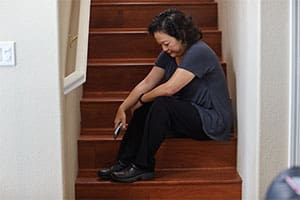 One goal is to identify a research agenda, including discovering gaps in knowledge and testing interventions, to better support caregivers. Another involves developing the research necessary to inform health policy changes, then collaborating with thought leaders to advance the needed changes, according to Harvath.
One goal is to identify a research agenda, including discovering gaps in knowledge and testing interventions, to better support caregivers. Another involves developing the research necessary to inform health policy changes, then collaborating with thought leaders to advance the needed changes, according to Harvath.
On the educational side, the Institute plans to develop competencies and courses to enhance the knowledge of practicing nurses and other healthcare professionals, as well as determine what should be taught to students to help them successfully engage with family caregivers.
“Part of the challenge is that we don’t give nurses all the skills or the time to work with families,” Harvath said. “It’s not a failure of nursing, but a growing need that we must pay attention to.
“My hope is that schools of nursing all across the country start to think about how to infuse content about family caregiving into their curricula.”
The fourth area of focus involves developing even more multi-cultural strategies and tools for caregivers, including use of the simulation facilities at the Betty Irene Moore School of Nursing featuring a onebedroom apartment to prepare caregivers for the advanced skills they need.
“I’m very excited about the Institute,” Young said. “It fills a very important gap in healthcare delivery. It’s not only the right thing to do, but a necessity to improve the skills and well-being of all caregivers, whether within families or within broader communities as well.”
Susan Trossman is a writer-editor at ANA
Resources
For information about the Family Caregiving Institute and UC Davis SON
For caregiver medication administration videos
For videos and other related resources
October 2017 Frontline

